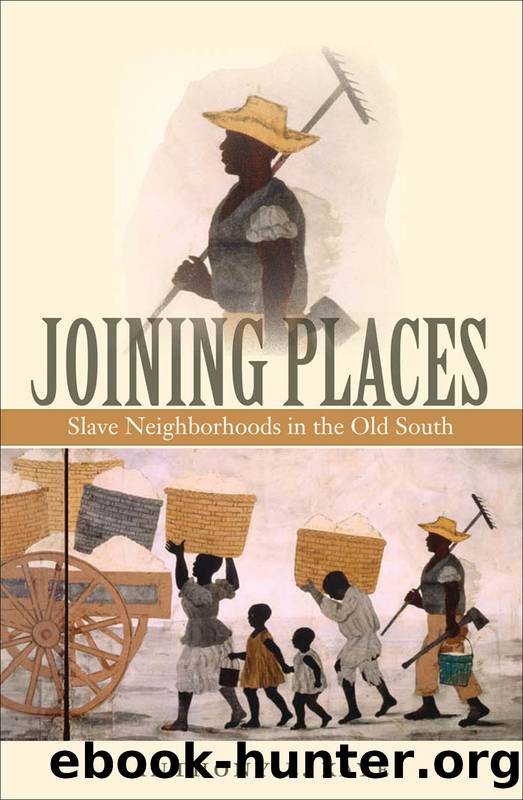Joining Places by Anthony E. Kaye

Author:Anthony E. Kaye
Language: eng
Format: epub
Publisher: The University of North Carolina Press
Published: 2010-07-14T16:00:00+00:00
Epilogue
Merrymon Howard, a former slave in Jefferson County who had gained his freedom during the mid-1850s, was disappointed in what he called “the new order of things” as it took shape in early 1866. Already in January it was enough to make him question the meaning of freedom itself. “[W]ell what sort of freedom is this,” he asked the Freedmen’s Bureau commissioner in Washington, D.C., “and what kind of free Country is this?” Recently enacted black codes, the letter continued, had pitted the law against the freedpeople, “and now we are for bid & denide the right of renting” land, doing business in town without a license, buying whiskey (“even for sickness”), and educating children.1 Howard was flabbergasted at the Yankees’ tardiness in coming to the defense of their allies by April, yet what he wanted from the government just then was a school. He volunteered propertied black people to pay a small tax to support the teachers, field laborers to throw in a share of their wages, and planters to administer the deductions. The planters, he suggested, “might establish Scholes in every neaborhood.”2 Howard envisioned a school system organized along neighborhood lines.
Neighborhoods persisted during Reconstruction, and they resembled their antebellum counterparts in important ways. As in slavery times, neighborhoods served as the locus of many different social relations after the Civil War, including some of the same relations, especially work and intimate relations. The reconstitution of neighborhoods was an unintended consequence of freedpeople’s other everyday activities, just like the creation of slave neighborhoods. The very work of remaking neighborhoods was familiar to freedpeople, for that was a constant of slave neighborhoods, too.
Yet freedpeople did not simply re-create slave neighborhoods, not to a tee, anyway. Intimate relations were the most binding tie in the neighborhood before the war, but afterward relations of labor were most important to neighborhoods in the making. Freedpeople’s neighborhoods, moreover, were bigger than slave neighborhoods. Bigger neighborhoods meant fewer neighborhoods. And because the social terrain was less divided by neighborhoods, folks coalesced more readily than ever across those lines. Freedpeople also laid the groundwork for new institutions in the neighborhood: schools, churches, the Republican Party, and its offshoots. As former slaves politicized neighborhoods in new ways, they transformed the terms of struggle with former slaveholders. Freedpeople’s mobilizations around election time made neighborhoods a fulcrum in the struggle for state power. And this democratic reconstruction of the neighborhood terrain helps to account for the violent character of the opposition to Radical Reconstruction.
Freedpeople were quick to return to their old neighborhoods after the war. From the outset of the fighting, slaves across the Natchez District had breached the boundaries between neighborhoods and cobbled them together into extensive lines of communication to gather military and political intelligence. After the Union army rolled into the neighborhoods, men left to enlist or join the ranks of military laborers, women followed to work in the camps, and many went back and forth with impunity. Their social terrain seemed to know no neighborhood bounds at all for a time.
Download
This site does not store any files on its server. We only index and link to content provided by other sites. Please contact the content providers to delete copyright contents if any and email us, we'll remove relevant links or contents immediately.
| Africa | Americas |
| Arctic & Antarctica | Asia |
| Australia & Oceania | Europe |
| Middle East | Russia |
| United States | World |
| Ancient Civilizations | Military |
| Historical Study & Educational Resources |
Goodbye Paradise(3460)
Men at Arms by Terry Pratchett(2686)
Tobruk by Peter Fitzsimons(2380)
Arabs by Eugene Rogan(2198)
Pirate Alley by Terry McKnight(2132)
Borders by unknow(2121)
Belonging by Unknown(1736)
It's Our Turn to Eat by Michela Wrong(1595)
The Biafra Story by Frederick Forsyth(1564)
Botswana--Culture Smart! by Michael Main(1487)
The Source by James A. Michener(1460)
A Winter in Arabia by Freya Stark(1449)
Gandhi by Ramachandra Guha(1437)
Coffee: From Bean to Barista by Robert W. Thurston(1422)
Livingstone by Tim Jeal(1396)
The Falls by Unknown(1374)
The Shield and The Sword by Ernle Bradford(1316)
Africa: Altered States, Ordinary Miracles by Richard Dowden(1296)
Egyptian Mythology A Fascinating Guide to Understanding the Gods, Goddesses, Monsters, and Mortals (Greek Mythology - Norse Mythology - Egyptian Mythology) by Matt Clayton(1279)
